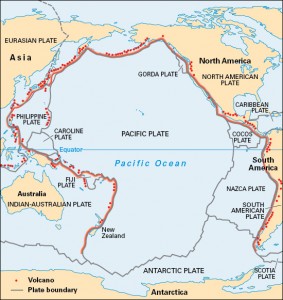Earthquakes
April 18, 2016

Most of the world’s earthquakes occur in the area of the Pacific Ocean known as the Ring of Fire. Both Japan and Ecuador are located in this seismically active region. Credit: WORLD BOOK map
Deadly earthquakes struck in Asia and South America over the last few days. In Japan, an earthquake with a magnitude of 6.2 struck the island of Kyushu on Thursday, April 14. Another 7.0-magnitude earthquake struck the same island two days later. Nine people were killed in the April 14 earthquake and more than 30 people died on April 16. After the second quake, heavy storms began in Japan, hampering rescuers racing to save people buried in landslides. Another earthquake—an aftershock—with a magnitude of 5.3 shook Japan today.
On April 16, Ecuador experienced a 7.8-magnitude earthquake. More than 300 people died in this quake. Although the strength of the Japan and Ecuador earthquakes may seem similar, because of how Richter magnitude is computed, each number on the Richter Scale represents a release of about 32 times the energy represented by the next lowest number. At a magnitude of 7.8, the Ecuador earthquake was about 20 times stronger than the 7.0-magnitude quake in Japan on April 16.
Both Japan and Ecuador are located on the Ring of Fire, a seismically active section of Earth created by the movement of tectonic plates. Experts state, however, that the Japan and Ecuador earthquakes were unrelated events. The areas are 9,000 miles ( 14,484 kilometers) apart, and they experienced different types of earthquakes. The earthquakes in Japan were of the strike-slip variety at a fault line (a break in Earth’s crust). In Ecuador, the quake was caused by tectonic plate activity at a subduction zone, where the Nazca Plate is slipping beneath the South America Plate.


